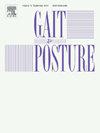Foot kinematics and running dynamics in children and adolescents with flexible flatfoot
IF 2.2
3区 医学
Q3 NEUROSCIENCES
引用次数: 0
Abstract
Background
Flexible flatfoot (FFF) is prevalent in children and adolescents, often leading to pain and limited sports performance. Running poses unique challenges for individuals with FFF due to altered biomechanics, which may increase discomfort and injury risk. While adult studies highlight running-related foot dynamics, research on children and adolescents with FFF remains limited.
Research question
How do running dynamics differ between children and adolescents with FFF and those with normally developed feet (NF), and how does running type (rearfoot vs. forefoot) influence these dynamics?
Methods
This study included 84 children and adolescents (7–17 years) with FFF and 53 with NF. Participants underwent clinical assessments and instrumented gait analysis, capturing kinematic and kinetic data during barefoot running at self-selected speeds. Analyses examined the relationship between passive ankle dorsiflexion and running type, as well as foot shock absorption during impact and propulsion during push-off. Two-factor ANOVA compared foot conditions and running types.
Results
FFF participants showed reduced passive ankle dorsiflexion, especially in habitual forefoot runners, with forefoot running less common in the FFF group (31 %) compared to NF (53 %). Forefoot runners exhibited greater rearfoot eversion excursion and velocity, but these differences were not significant between FFF and NF. Rearfoot runners demonstrated higher peak loading rates across both groups. FFF participants also had lower ankle strength, hindfoot inversion velocity at push-off, and generated reduced ankle moments and energy for propulsion compared to NF.
Significance
This study identifies biomechanical differences in individuals with FFF using a forefoot strike pattern, which may influence loading patterns. Although injury risk was not directly assessed, future research could explore whether improving ankle strength and flexibility may help mitigate potential disadvantages in FFF.
儿童和青少年柔性扁平足的足部运动学和跑步动力学
背景:柔性扁平足(FFF)在儿童和青少年中很普遍,经常导致疼痛和运动表现受限。由于生物力学的改变,跑步对FFF患者带来了独特的挑战,这可能会增加不适和受伤的风险。虽然成人研究强调与跑步相关的足部动力学,但对儿童和青少年FFF的研究仍然有限。研究问题:患有FFF的儿童和青少年与足部正常发育的儿童和青少年(NF)的跑步动力有何不同?跑步类型(后脚和前脚)如何影响这些动力?方法选取FFF患儿84例,NF患儿53例,年龄7 ~ 17岁。参与者进行了临床评估和仪器步态分析,以自行选择的速度赤脚跑步时捕获运动学和动力学数据。分析检查了被动踝关节背屈与跑步方式的关系,以及冲击时的足部减震和蹬离时的推进力。双因素方差分析比较了足部状况和跑步类型。结果FFF参与者表现出被动踝关节背屈减少,特别是在习惯性前足跑步者中,与NF组(53 %)相比,FFF组(31% %)的前足跑步较少。前足跑者表现出更大的后足外翻偏移和速度,但这些差异在FFF和NF之间不显著。后足跑者在两组中表现出更高的峰值负荷率。与NF相比,FFF参与者的踝关节力量、蹬蹬时后脚翻转速度也较低,踝关节力矩和推进能量也较低。意义:本研究确定了FFF患者使用前足击球模式的生物力学差异,这可能会影响负荷模式。虽然没有直接评估损伤风险,但未来的研究可以探索提高踝关节力量和柔韧性是否有助于减轻FFF的潜在缺点。
本文章由计算机程序翻译,如有差异,请以英文原文为准。
求助全文
约1分钟内获得全文
求助全文
来源期刊

Gait & posture
医学-神经科学
CiteScore
4.70
自引率
12.50%
发文量
616
审稿时长
6 months
期刊介绍:
Gait & Posture is a vehicle for the publication of up-to-date basic and clinical research on all aspects of locomotion and balance.
The topics covered include: Techniques for the measurement of gait and posture, and the standardization of results presentation; Studies of normal and pathological gait; Treatment of gait and postural abnormalities; Biomechanical and theoretical approaches to gait and posture; Mathematical models of joint and muscle mechanics; Neurological and musculoskeletal function in gait and posture; The evolution of upright posture and bipedal locomotion; Adaptations of carrying loads, walking on uneven surfaces, climbing stairs etc; spinal biomechanics only if they are directly related to gait and/or posture and are of general interest to our readers; The effect of aging and development on gait and posture; Psychological and cultural aspects of gait; Patient education.
 求助内容:
求助内容: 应助结果提醒方式:
应助结果提醒方式:


